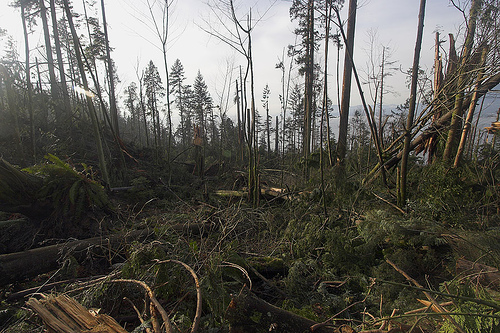Information Forestry, December 2009 —

In 2009, Vancouver’s renowned Stanley Park was discovered to be home to 31 invasive moth species, four of which were identified in British Columbia for the first time. Photo by outdoor PDK.
Emerging DNA-screening technologies can play a vital role in detecting and identifying potentially problematic pest insects in Canadian forests, according to a recent insect survey conducted in Vancouver’s Stanley Park by Natural Resources Canada, the University of British Columbia and other agencies. In the survey, DNA screening uncovered 31 non-native moth species established in the 120-year-old urban park.
Four of the non-native species were not previously known to be established in British Columbia; three of those four are new records for North America.
“These are phenomenal results, considering only 190 species were collected,” says Natural Resources Canada Research Scientist Lee Humble. “The DNA analyses helped us zero in on species identities.”
Humble has been conducting surveys for alien insects in forested areas throughout British Columbia’s lower mainland for 14 years. In 2007, in cooperation with the University of British Columbia forestry department, the Metro Vancouver Parks Board and the Canadian Food Inspection Agency, he extended his research to include Stanley Park. Humble supplied light traps for the university-led insect inventory and developed protocols for collecting moths using light at sampling locations in the 400-hectare urban park. The park survey was initiated after the December 2006 windstorm toppled old-growth trees and caused more than $12 Million of damage to the park’s forests.

Damage by wind storm to the old-growth forests of Vancouver’s Stanley Park in 2007 prompted a survey for insects, which were identified using DNA-barcode screening. Photo by Jenny Lee Silver
Humble and Ph.D. candidate Jeremy deWaard used the survey to populate the DNA database of Canadian Lepidoptera for the Canadian Barcode of Life project, an initiative based out of the University of Guelph, in Ontario. Like the universal product codes on supermarket goods, the DNA segments that are analysed serve as species-specific identification tags that eventually could be cross referenced between the database and new samples collected in the field to assist with species detection and identification, track movement of species around the globe, and study evolution and biodiversity.
“The Stanley Park experience highlights many advantages to using barcoding in biodiversity inventories,” says deWaard, who contributed to development of DNA-barcoding methodology during his undergraduate and masters studies at Guelph.
DNA-barcode screening increased the accuracy of species identifications and speeded up the identification process to a matter hours per specimen compared to days or weeks using traditional methods. It also flagged specimens requiring further attention, thereby allowing trained taxonomists to focus on problematic identifications while non-specialists were able to confirm identities of the common, routine specimens.
“It allowed us to identify cryptic species, new species, species that don’t belong here, and species for which only single specimens were collected.”
For instance, DNA analysis of one lone specimen collected in the park indicated the moth closely matched the genus Prays from Eurasia.

Prays fraxinella, an invasive moth from Eurasia, found in Vancouver’s Stanley Park, thanks to DNA barcoding. Photo by oldbilluk.
“So right away we knew the family and had an indication of genus,” deWaard says. “In a quick discussion with colleagues, we learned of one specimen that had been collected in Newfoundland in the 1970s that was also a member of Prays, so we pieced it together, looked at the literature and examined our single Stanley Park specimen, and that’s how we arrived at the i.d.”
Prays fraxinella is one of the four survey identifications that represent new non-native moth records for British Columbia.
“The Stanley Park results demonstrate clearly how DNA screening can save time and resources, and provide reliable, accurate identification,” says Humble. “As the technology becomes more accessible and cost-effective, we’re going to see DNA screening become a regular part of the pest detection and monitoring toolkit.”
© Natural Resources Canada 2009

You must be logged in to leave a reply.